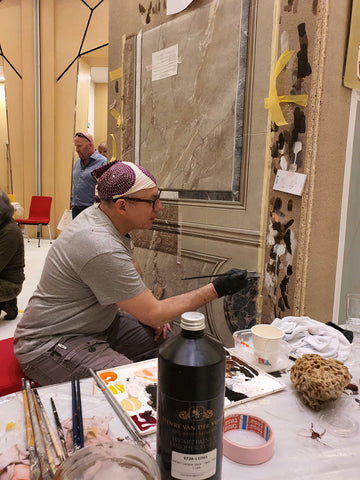HV’Art Decorative Canvas is a waterborne Color coat, designed for use over GSP or GSP+, in order to produce a tight base for the successful application of Artistic Finishes via a Glaze medium.
COLORS:
The application of Decorative Canvas allows the full benefits of Open-Time Glaze to occur.
It produces a consistent sealed base without creating issues of adhesion or preventing proper drying of subsequent coats.
GLOSS LEVEL:
Decorative Canvas is manufactured as 15% sheen, producing a dense base for the application of Glaze.
Decorative Canvas is available in the full mixed colour spectrum, to assist with creating a background of whatever tone is required.
AREA OF USE:
Wall surfaces, ceilings, and any interior substrate previously primed with GSP or GSP+, require the ideal surface for decorative Glaze.
METHOD OF APPLICATION:
Synthetic brush & fine-haired rollers
MIXING PROCEDURE:
Ready to use, can be thinned with drinking water up to 10% for increased flow if needed.
Technical Characteristics:
Solid content (%) Specific gravity (kg/l) Viscosity
VOC Content: 37 g/ltr
DRYING:
Touch dry (room temperature): 2 hours Sandable (room temperature): 4 hours
Drying times are indicative because they depend on temperature, humidity, & importantly air flow conditions.
Drying of waterborne products must take place at temperatures not below 15°C and at a relative humidity preferably not exceeding 85%. Out of these limits, there is a slowing down of the drying and/or formation of a less hard and resistant film. It is always advisable for drying to be forced, with air previously de-humidified and warm (20-30°C).
COVERAGE:
200-220 Square Feet per Coat/Liter
Buy HV'ART Lacquer Paint System Click Here
Sign up for Training Click Here
Introducing the Advanced System
The HV’ART Advanced Lacquer Paint System takes the original, industry-leading formula and re-crafts it with the latest water-based technology. This evolution delivers unmatched performance, deeper colour density, and environmental responsibility. It’s a superior product engineered specifically to meet high-end decorative needs, proving that environmentally conscious, water-based solutions are the future.
About the Product

The HV'ART Lacquer Paint System can be made in any color, has a hard crystal quality, a soft silky-smooth finish and in formulation is equivalent to the paints & lacquers used by premium furniture makers. Included in the system are: adhesion promoting primers & undercoats, tinted lacquer paint for furniture painting & a ‘Decorative Canvas’ as a base for decorative glazes. There are four different setting ‘Lacquer Glazes’ for all decorative finishes & a range of crystal lacquers with 9 sheens available starting from ‘Mineral 00’ Deep Flat working their way incrementally to the ‘Ceramic 90’ Ultimate Gloss. These lacquers can be used in conjunction with the HV’Art additives for ultimate durability.
Formulated in the United Kingdom by the HV'Art team for Henry Van Der Vijver Decorative Artworks.
Achieve Ultra High-Gloss
A luxurious ultra high-gloss mirror finish can be achieved through the process of application, followed by sanding with a high quality low variable speed handheld sander, and then reapplication. Each lacquer sheen can have a natural finish with fine brush strokes or can be sanded to a mirror like effect.

Our Eco-Friendly Stand
Water-based solvent free: We have been instrumental in the environmentally friendly water borne paint movement in the UK and although est. in 1988 the business has been trading as a ‘Green’ business since 1996 believing in looking after the planet, ourselves & our clients. It is our policy to use as few if any solvents as possible. We combine traditional skills with the continual improvement in modern waterborne technology so that our designs and finishes create minimal environmental impact. Unlike traditional oil-based paint systems our finishes are multi layered & quick drying making their conservation more cost effective. We use our own HV’ART Lacquer Paint™ system for basecoats, furniture painting, decorative glaze finishes & lacquering & other than any specialist primers and stoppers this system is relatively odorless, solvent free, colour-fast & non-yellowing which ensures that there will be minimal if any discoloration even in direct sunlight or behind furniture & paintings etc.
Developed in the U.K.
The HV'Art product range has been developed by the team of craftsmen at Henry van der Vijver in London. It is a unique waterborne, environmentally friendly paint and lacquer system for specialist surface designs and finishes.
Distribution in North America
FauxBrushes.com is proud to be the exclusive North American distributor of HV'ART Lacquer Paint System.










